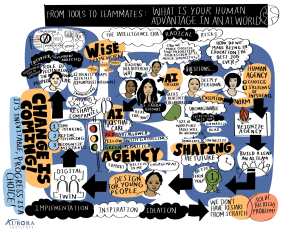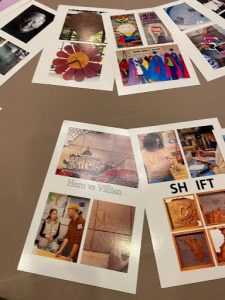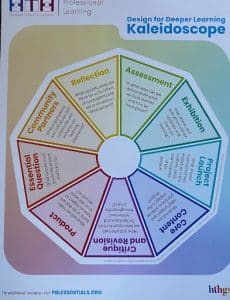Busting Barriers with AI
CompetencyWorks Blog
This post is part of our Aurora Institute Symposium 2024 series sharing ideas from #Aurora24. AI presents key opportunities and challenges for the CBE field and education overall.
 Artificial Intelligence (AI) can be a bit intimidating – I get it. But after three days at the Symposium, I found myself just as excited as I am cautious. Why? Because I’ve seen how AI can break down barriers that have challenged us for years.
Artificial Intelligence (AI) can be a bit intimidating – I get it. But after three days at the Symposium, I found myself just as excited as I am cautious. Why? Because I’ve seen how AI can break down barriers that have challenged us for years.
Schools making the shift to competency-based education (CBE) face some unique hurdles, many of which boil down to a matter of time. Teachers need more time to design or co-design projects, give meaningful feedback, and review student revisions. From the student’s perspective, feedback is essential. Without timely, constructive input, progress stalls. Feedback drives meaningful revision, and revision is key to mastery – one of the three pillars of building agency and intrinsic motivation.
The reality is that every student enters the classroom with a different level of understanding, a unique skill set, and varied interests. This makes it nearly impossible for teachers to meet each student’s needs without risking burnout. Here’s where AI steps in – not to replace teachers, and not merely as their assistant, but to open new doors for students to receive the feedback they need, right when they need it.
Creating a Fast Feedback Loop in the Learning Cycle
Building 21, in partnership with PlayLab, is using AI to expand the learning cycle, creating a fast feedback loop that keeps the momentum of growth going. At Building 21, student growth is the priority, with credits awarded for learning, not simply course completion. They’ve developed a new capacity that allows students to access feedback quickly so they can continue working toward mastery.
Through Building 21’s Beacon learning management system, now with AI embedded, students submit essays stating which competencies they’re working on and their target stage. Building 21 has integrated its competency progressions into the AI system, along with rules on interpreting reference materials and responding to different types of requests. Students can ask for feedback based on their specific stage of progress. (Think zone of proximal development.) If students have multiple areas of weakness, they can request feedback multiple times until they achieve or exceed their learning goals.
For example, a student writing an essay on the Civil War might seek feedback for Social Studies 1.1, “Analyze Historical Causes and Outcomes,” at stages 8-10 out of 12. Based on the essay, AI might provide high-level guidance, such as: “To fully demonstrate Stage 10, consider developing your evidence further. Specifically, analyze how the economic, social, and political contexts you described influenced the Civil War’s outbreak. How did these factors interact to increase the likelihood of war?”
I had initially worried that AI might give overly specific feedback or even revise the essay itself. But it was the opposite with Building 21’s rules – the feedback was high-level, and I found myself having to turn on my brain to think about the question it asked. Plus, Building 21 has strict rules against AI editing the essay directly.
Building 21’s approach goes well beyond simply integrating AI. Their team has thought deeply about creating a system that aligns with their philosophy of competency-based education and student agency. I’m excited to see where they take this next – bravo, Building 21!
A quick aside: Tom Gaffey, one of the creators of Beacon, shared an interesting lesson. He noted that when he initially used the term “level,” AI interpreted it as a grade level, unable to envision a student-centered progression. Now, he uses the term “stage,” as in stages of growth. It’s a reminder that we need to teach AI about modern educational systems if we want it to be a real partner in designing our schools.
Expediting High-Quality Project-Based Learning

For those advancing project-based learning (PBL), one challenge is the expertise required to design high quality projects. Quality PBL is complex; it needs to spark curiosity while activating high-powered critical thinking. High Tech High Graduate School of Education (HTH GSE), in partnership with Inkwire, is developing an AI-supported approach to help teachers and students create deeper, more rigorous PBL experiences.
Understanding that relationships and connections are essential, the session began with each of us selecting a card describing an inspirational project. We shared ideas in small groups before diving into the 9-step “Design for Deeper Learning” Kaleidoscope. Once three key elements – like an essential question, community partners, and core content – are identified, the AI system offers ideas for the remaining steps. It will also create a plan with all the necessary steps.

HTH GSE and Inkwire have designed something that can save teachers a tremendous amount of time, while also empowering students to take ownership of their PBL projects. I believe that over time, this process will not only ease teachers’ workloads but also help them gain confidence in facilitating projects that foster critical skills and competencies.
Personalizing Instruction and Assessment
Toddle, a learning management system, has incorporated AI to support curriculum development. One feature speeds up backward planning, a crucial process in Universal Design for Learning (UDL) that ensures accommodations and supports are in place from the start. Backward planning takes both time and expertise, and I wonder if, with AI’s help, special education experts and CBE advocates could collaborate to make CBE’s growth orientation even more responsive to students.
Imagining AI’s Potential
By the end of the Symposium I felt as if there were an infinite number of ways for AI to be helpful to students, teachers, and administrators. Most of them were time-saving. One favorite example? When running a session filled with sticky notes, just snap a picture, feed it to AI, and ask for a prioritized list. Add a few dots to indicate what matters most, and within moments, you have a clear sense of your community’s top priorities. Several people recommended 100 days of AI to learn its capabilities, and Designing Schools also offers an online course as well.
In the new digital age, we should embrace the challenges and opportunities of AI as a tool for implementing CBE. Let’s keep imagining the possibilities for leveraging AI to meet learner-centered goals.
~~~
This article was based on conversations and sessions:
Conversations Building 21 Team including Laura Shubilla, Co-CEO; Thomas Gaffey, Senior Vice President of Technology and Innovation; and Sandra Moumoutjis, Executive Director of the Learning Innovation Network
Leading with Foresight: Advancing Competency-Based Learning in an AI-Driven World with Dr. Sabba Quidwai, CEO of Designing Schools
Designing Transformative Learning Experiences Using AI: Paola Capo-Garcia, Professional Learning Coordinator, High Tech High Graduate School of Education; Kali Frederick, Professional Learning Designer, High Tech High Graduate School of Education; and Aatash Parikh, Founder, Inkwire
Unlocking Potential: The Dynamic Duo of AI and UDL with Cindy Blackburn, Director of Learning and Engagement, Toddle
Learn More
- The Field of Competency-Based Education Is In Motion
- An AI Design Sprint: A Glimpse into the Future of Education
- Chicago Students Build Key Adaptive Competencies while Exploring the Boundaries of AI and Creativity

Chris Sturgis has spent her professional life building national collaborative efforts to bring about improvements in the education system. She was one of the leaders in creating the policies for multiple pathways to graduation. As co-chair, she enabled the philanthropic members of the Youth Transition Funders Group to work together across the sectors of juvenile justice, foster care, education, and workforce development toward a vision of Connected by 25. Most recently, she co-founded CompetencyWorks, the go-to source about competency education. In 2018, she was awarded Outstanding Individual Contribution to Personalized Learning Award by iNACOL.